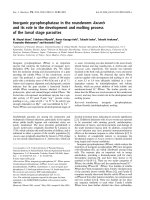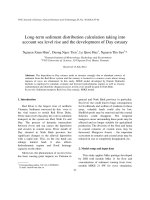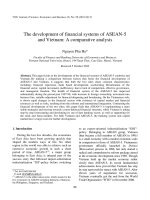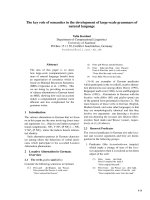History of the Development of Cataract Surgery
Bạn đang xem bản rút gọn của tài liệu. Xem và tải ngay bản đầy đủ của tài liệu tại đây (31.3 KB, 2 trang )
Paramedical
History of the Development of Cataract Surgery
Sr. Varghese, Aravind Eye Hospital, Madurai
Cataract is the most common cause of curable
blindness in India. Our current knowledge of the
disease indicates that there is no effective medicinal
treatment; the only curative treatment for cataract
being surgery.
Many years ago, surgery was performed only
when a patient suffered from a matured cataract.
Good vision is an increasingly important aspect of
patients lives, however, and is particularly crucial to
most occupations. Today, an individual’s needs rather
than the degree of maturity of the cataract, dictates
when surgery is indicated.
The first surgical procedure for cataract was
couching, or displacement of the lens into the vitreous
cavity. This technique was introduced by Susruta,
the sclera was pierced with a sharp instrument and a
blunt instrument was inserted into the anterior
chamber to depress the lens.
In 1748 a British surgeon, Laques David,
performed an extracapsular cataract extraction
(ECCE). This method involved removal of the cortex,
nucleus, and the anterior capsule of the lens, but
preservation of the posterior capsule, which remained
inside the eye.
During this period, suture material was not available,
so the incision was left unstitched. Patients were
advised to remain in bed after surgery, and to keep
the eye bandaged for several days. Minimal straining
would cause dehiscence of the surgical wound,
prolapse of the internal structure of the eye and
infection. Since the procedure was so delicate, many
patients lost their sight.
In 1867 Dr. Williams was the first surgeon to use
sutures in cataract surgery. Eye surgeons around the
world followed his example of using sutures to close
the surgical wound. Since then this became standard
practice.
In 1753 Dr. Samuel performed intracapsular
cataract extraction surgery by applying pressure to
the eyeball with his thumb. Colonel Henry Smith
popularised this technique, practicing it on many
patients in India from 1900 to 1926.
Intracapsular extraction is performed on patients
over 50 years of age. In this method, first a
conjunctival partial thickness incision is made in the
upper part of the corneal-scleral junction, followed
by a stab entry with a blase blade into the anterior
chamber. The incision is completed with corneal
scissors, and a peripheral iridectomy is performed to
prevent aphakic glaucoma.
Intracapsular cataract extraction has been
modernised by several methods
To hold the anterior
1. Capsule - holding forceps
capsule to remove
2. Erisophake
the lens.
3. Modified Smith - Indian technique: using a hook
and a spatula to remove the lens.
4. Cryo extraction: This procedure is performed
with a cryogenic (cryo) probe from a cryo unit.
The cryo probe is manipulated according to the
joule thomson principle of cooling. The gas used
as a cooling agent in the cryo unit is nitrous oxide or carbon dioxide. The cryo probe is 1.5mm
in length and may be straight or curved. The temperature produced depends upon the size of the
cryo tip, the duration of the freezing process and
the type of gas used. When the foot pedal of the
cryo instrument is depressed, the pressure decreases, causing gas to filter through a small
opening in the cryo probe. This process results
in cooling to 4 oC and the formation of a ball of
ice on the capsule. Finally, the cataractous lens
is removed and the wound is closed with fine
sutures.
Cryo extraction is more popular than other
methods of intracapsular extraction.
Extracapsular cataract extraction
The initial step of this surgical procedure is identical
to that of the intracapsular cataract surgery. After
making the stab entry into the anterior chamber of
the eye, an anterior capsulotomy is performed on
the lens. When the incision has been completed, the
38
nucleus is removed (using an instrument called vectis)
and the cortex is aspirated with a simcoe cannula. The
incision is closed with sutures.
Harold Ridley modernised this technique in 1949 by
implanting an intraocular lens after extracting the
cataractous one.
Ridley was inspired during the second world war
when he realised that fragments of canopy (a material
that covered British fighters flight) which had fallen
into a pilot’s eye did not produce an adverse reaction.
The canopy was made of a plastic material known as
polymethyl methacrylate. Ridley had an intraocular lens
made of this material. On November 29, 1949 he
became the first person to implant such a device.
Since then, the intraocular lens has undergone
several modifications. The initial lens was placed in
the anterior chamber, between the iris and the cornea,
and supported by the iris. Since many complications
arise from this placement, surgeons began placing the
lens in the posterior chamber. Fewer complications
were seen with posterior chamber lenses; they are
commonly used today. Ninety-nine percent of cataract
surgeries now involve intraocular lens implantation.
SISCS - Small Incision Sutureless Cataract
Surgery
This method involves making a tunnel incision, about
5mm in length, in the superior side of sclera and
performing paracentesis 3mm from the tunnel. After
capsulorhexis on the lens and hydrodissection, the
nucleus is flipped within the anterior chamber and
removed with a vectis. The cortex is then aspirated
with a simcoe cannula. An intraocular lens is placed
in the bag.
This procedure replaces the phacoemulsification
technique because it results in the same visual
rehabilitation.
Illumination
The most recent development in intraocular
implant surgery is a “sutureless” technique using
phacoemulsification, which was introduced by
Dr. Kelman in 1967. The sophisticated instrument
used in this surgery allows the cataractous lens to
be removed through a very small (3.2mm), bevelled
incision. A foldable intraocular lens is then inserted
through the incision. By extending the tunnel to a
width of 5mm, a routine single-piece lens may also
be implanted. In most cases this incision does not
require sutures, and the post operative rehabilitation
period is short.
In 1960 Harold Scheic introduced a cataract
aspiration system for use in patients with immature,
congenital or traumatic cataracts.
Treatment modalities for children
1. Lensectomy: An incision 3 to 4mm in length is
made in the sclera, 3.5mm from the limbus. An
opening is made in the capsule and cortex with
a knife, and an instrument called a vitrectomy
lensectomy probe is used to aspirate the lens
matter. Following this surgery contact lenses
or glasses are prescribed to correct the refractive error.
2. Lens aspiration: A small incision is made in the
corneo-scleral junction, after which an anterior capsulotomy is performed and the cortex
of the lens is aspirated.
3. Extracapsular cataract extraction (ECCE) and
IOL implantation: This procedure is performed
in children over three years of age
Suggested readings
1. Gupta, A.K, Cataract: 32-47.









